What do Pump Pros Know and why do they know it? This series of articles highlights the brilliance of those who work with pumps. Read more Pump Pros Know.
System designers have what seems like an endless range of parameters to calculate when trying to optimize a pumping system. These calculations generally require compromising one choice for another to best serve the application. In fact, what is optimal for one application may be vastly different than that of another. This is why it’s important to evaluate all system parameters for a given application.
Of course, most compromises usually focus on economics, so the degree to which a system can be optimized for a particular application depends on the budget. In the end, systems are generally optimized based on total cost of ownership. This usually means spending more for a system up front that will operate with lower energy consumption, require less maintenance, have higher reliability, and achieve greater longevity than a system based primarily on initial cost.
Pump Selection
Sizing and selecting a pump based on application, and hydraulic requirements, requires experience. For example, rotodynamic pumps are usually selected when pumping water or aqueous solutions, especially when high flows at low to moderate pressures are required. Positive-displacement pumps are widely used with more viscous fluids and when constant flow is required at multiple pressures, or when very high operating pressures are involved.
Selection also depends on fluid characteristics, temperatures, flow ranges, and maximum system pressure. For instance, if a system or particular application requires a constant flow rate for extended periods of time, a standard pump and motor combination (if sized correctly) will provide the most energy efficient solution. If the constant flow application requires frequent downtimes, the use of a soft start or variable-speed drive (VFD) will limit the inrush current and provide greater longevity to the motor. If the application requires fluctuating rates of flow or pressure, the use of a variable-speed drive (VFD) may be the best solution. However, this will depend on the system, as extremely small adjustments in flow may be best controlled by throttling.
Electrical Energy Consumption
Simply put, the vast majority of the electrical energy consumed by a pumping system is attributed to the electric motor driving the pump. Power transmitted by the electric motor drives the pump which in turn moves fluid through a network of pipes, valves, fittings, and other components that contribute to the systems friction losses.
The design and construction of the motor itself plays an important role in energy efficiency and energy consumption. Many factors affect a motor’s efficiency, such as physical clearances, conductivity of materials, ambient temperature, and cleanliness of the environment.
Most pumping units are supplied with an alternating current (AC) induction motor, which operates most efficiently at nearly full load—roughly 60% load or greater. However, the efficiency reduces significantly if the load falls below 50%. Exacerbating the effects of lower efficiency is the motor’s power factor, which is the ratio of real power absorbed to the apparent power or the relationship (cosine of the phase angle) between the motor’s input voltage and input current. Even if two motors are the same, it costs more to drive one with a lower power factor than it does one with a higher power factor. Therefore, selecting a motor that will run near full load is essential to system optimization.
Free Flow Means Higher Efficiency
Choosing the optimum pump and motor combination often seems like the key to an efficient system. But don’t overlook design techniques that can reduce the power required by the pump. For example, larger diameter system piping offers less resistance to flow than smaller ones. Less resistance means lower pressure required by the pump. This, in turn, allows the system to be more energy efficient.
The same strategy applies to valves, heat exchangers, filters, and other components. Specifying components with larger connection sizes may cost more initially, but they can reduce energy consumption over the life of the system. Furthermore, elbows, tees, reducers, and other types of fittings contribute to friction losses within the system. So it’s best to carefully plan circuits with as few twists, turns, and bends as possible.
What Sensors and How Many?
Pressure, temperature, flow, and other types of sensors indicate process conditions for manual and automatic observation, and to aid in troubleshooting. Almost all pumping systems use some sort of sensor—from simple pressure and temperature gauges to electronic transducers that route electronic signals to automatic controls or to computers plant-wide for process automation.
Strategic placement of sensors can also aid in the mean time between maintenance (MTBM) and for system troubleshooting. For example, a differential pressure transducer can indicate when a filter element needs to be changed. Pressure and temperature switches can also be placed and set to give a warning or even shut down a machine if a pressure or temperature exceeds a predetermined level.
Pressure and flow sensors can also indicate operating conditions to help pinpoint a malfunction. Knowing the flow patterns and pressure drops within the piping circuit when a system is new provides a benchmark for diagnosing where a problem lies if a system’s productivity reduces over time, or suddenly changes.
A change in an machines vibrational signature is a sure sign that something has caused an imbalance in the rotating element. This imbalance is often a symptom of wear or contamination. Vibration sensors (accelerometers) can be provided to detect vibration in pumps, motors, and other components to warn of impending failure so the problem can be addressed before failure occurs.
Longevity & Reliability
Every system design has an expected lifespan. Ideally, they will operate reliably and efficiently until newer technology renders them obsolete. So to maximize longevity of a pumping system they should be designed so that key components can be replaced with more efficient ones years later. These may include pumps, motors, valves, filters, heat exchangers, and other components that constantly undergo improvement cycles. Naturally, then, these components should be installed in easily accessible locations.
Some components need periodic maintenance based on the nature of their function. For example, heat exchangers need to be removed from the system in order to clean there small passageways. Filters should also be installed at locations for easy access. Depending on how often they must be actuated, valves contain moving parts that can wear over time.
In reality, some components require periodic or regular maintenance. Filter elements must be changed, and others must be kept clean and lubricated. Components rated as lubricated for life generally provide no provision for lubrication, so they eventually must be replaced, rather than simply just relubricated.




